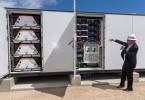Audit: Nevada inspects oil, geothermal wells infrequently
CARSON CITY — The Division of Minerals seldom inspects the 430 geothermal and 111 oil wells in the state and in one instance relied on an email from the oil producer that he had performed a required test on blowout prevention equipment.
So says a legislative audit released Tuesday that also noted that a well blowout occurred in December 2011 in rural Nevada. That blowout, which was blamed on defective equipment, took five days to control.
There also was a 2010 incident where geothermal fluids and steam temporarily flowed uncontrollably on the surface.
No one was hurt in either incident.
“Although it is not known whether inspections would have detected problems at these wells, inspections provide an opportunity to identity potential problems before any damage is done,” stated the audit released to the Legislature’s Audit Subcommittee.
Subcommittee Chairwoman Maggie Carlton, a Democratic assemblywoman from Las Vegas, expressed concerns about the dangers of blowouts, noting the damage caused along the Gulf of Mexico following an offshore blowout in a BP well in 2010.
“We don’t need an incident like that in the middle of the desert,” she said.
But the audit noted there is only one person in the Minerals Division dedicated to managing oil, gas and geothermal operations. Auditors reviewed records of 10 tests involving blowout prevention equipment and found none were witnessed by the Minerals Division.
Regulations at this point do not provide alternatives for state workers other than viewing the blowout prevention tests in person. The agency is working on regulations that would provide other ways for verifying the tests.
Rich Perry, administrator of the Minerals Division since November, accepted auditors’ recommendations to document that oil, gas and geothermal operations will be inspected. Initial inspections of every well should be completed by the end of March.
So far only signage problems and “one minor water drip” at an oil well have been discovered, he said in his audit response.
He said the regulation that blowout prevention tests “must be witnessed” dates back to 1985 and technical advances since that time have reduced the need for their attendance.
“The level of sophistication of modern drilling rigs has advanced to the point that all operation parameters and functions are automatically recorded and often transmitted in real time,” said Perry.
He added that the state and the U.S. Bureau of Land Management have an agreement designed to prevent duplicate inspections. Almost all oil wells are on public land, while the ones that the state generally checks are geothermal wells on private property. According to auditors, the BLM inspects wells on a three-year cycle.
Interestingly, the audit also provided information on oil and geothermal production in Nevada. In 2012, 2.4 million megawatt hours of electricity were provided by Nevada geothermal wells, mostly found in Churchill and Washoe counties. That’s enough to power 219,000 homes.
Oil wells, mainly in rural Nye County, produced 367,994 barrels in 2012, which sounds like a lot, but the Texas Eagle Shale region in South Texas alone produces more than 1 million barrels a day.
Contact Capital Bureau Chief Ed Vogel at evogel@reviewjournal.com, call 775-697-3901. Follow him on Twitter @edison vogel.























